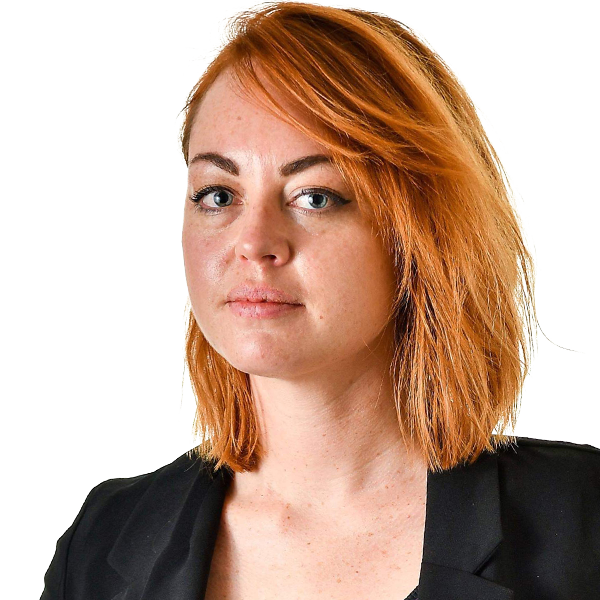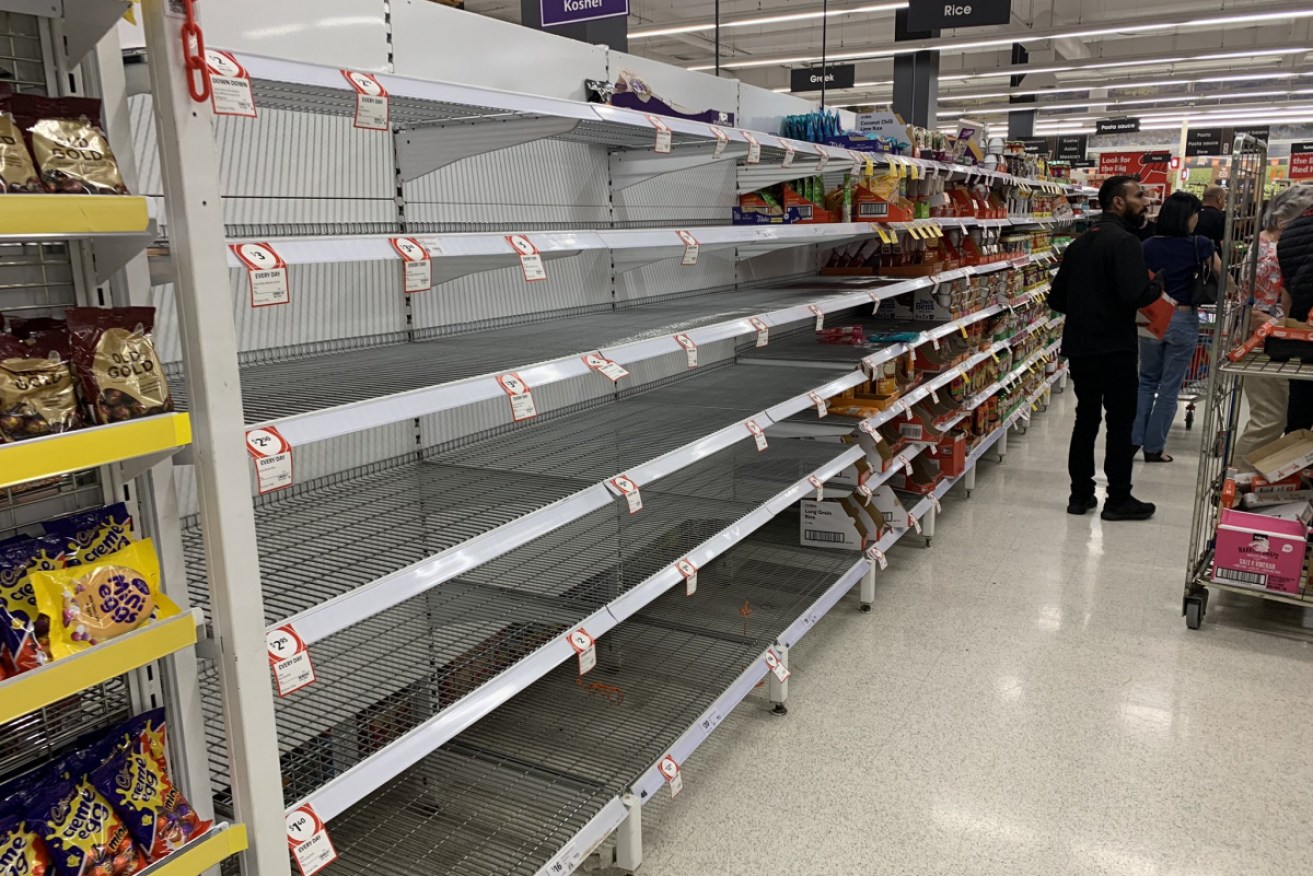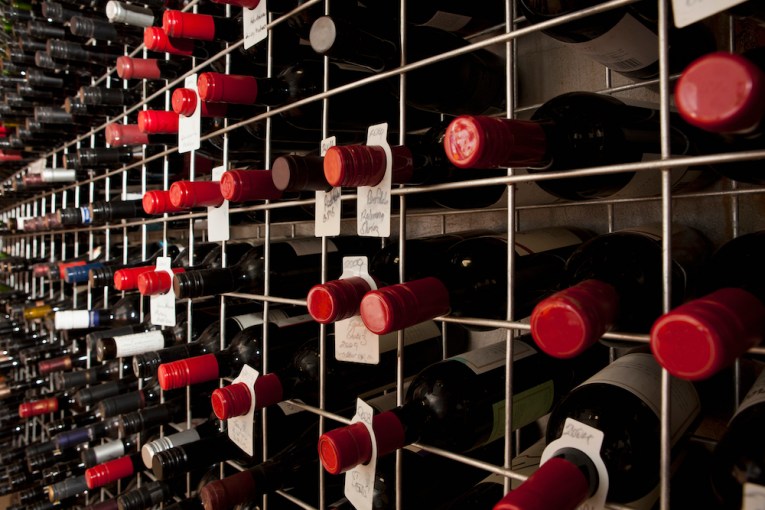Panic buying in the age of coronavirus: Why shoppers need to calm down


'Panic buying' images are spreading on social media, contributing to the stockpiling cycle. Photo: Twitter/@DavidCaoEV
Supermarkets have gone into overdrive to keep up with the demand for non-perishable groceries, as shoppers wipe shelves clean in coronavirus’ continued global stranglehold.
Whipped into a frenzy by a growing number of seemingly ransacked supermarket shelves posted to social media, Australian shoppers are stockpiling packet pasta, rice, canned goods and toilet paper in what has become a ‘panic buying’ epidemic.
Retail industry experts and Prime Minister Scott Morrison have both said photos like these make the situation look worse than what it really is – but their comments have done little as the social media storm gathers strength.
Public figures have only poked the fears further: Rebecca Judd posted an Instagram video of her neighbourhood supermarket’s usually packed toilet paper aisle, apparently now virtually empty.

Footballer’s wife Rebecca Judd filmed the empty shelves at Brighton Coles for her million-plus Instagram followers. Photo: Instagram
Both Coles and Woolworths told The New Daily they had seen a spike in demand for long-life pantry and household items in the past few days.
A Woolworths spokesperson said the sudden surge had led to “partial stock shortages” across some of its stores.
Coles has ramped up its distribution-to-store deliveries this week, and said its teams were diligently working to fill shelves as quickly as possible.
Both supermarkets acknowledged they were still experiencing severe shortages of hand sanitisation products.
Public Service Announcement:
Most, if not all, toilet paper is made in Australia. It is NOT imported.
The manufacturers are ramping up production to replenish shelves stripped bare by panic buying.
Australia will not run out of toilet paper.
So, everybody can calm down. pic.twitter.com/AcdlUYgIjF
— Michael Rowland (@mjrowland68) March 3, 2020
Don’t panic (buy)
Mr Morrison said he’d been in contact with Coles and Woolworths about the perceived shortages, in a bid to allay the public’s panic.
“The prolific nature of this has been presented on social media and things like that. It is not as widespread as those images suggest,” Mr Morrison told a press conference on Tuesday.
- Related: Doctors slam face mask price hikes
“What (supermarkets) were able to feed back to me was very positive and I’m pleased with the plans they have in place.”
https://twitter.com/ChantelleMary07/status/1234657417423511552
Retail marketing expert Gary Mortimer told The New Daily the situation was more headlines than reality, which was creating panic in some sectors of the community.
“There’s certainly fear and panic about potential shortages, but I don’t think they’re well informed,” said Associate Professor Mortimer, of Queensland University of Technology.
The head of the Australian Retailers Association backed up Professor Mortimer’s statements.
Russell Zimmerman said via a statement on Tuesday that all indications showed stock levels remained solid, and consumers had no need to panic.
Mr Zimmerman said he had spoken with the two major supermarkets, among other retailers, and said any empty shelves were not representative of warehouse inventory levels.
It’s not the tip of the iceberg
Professor Mortimer explained supermarkets’ business plans were based on having the lowest possible levels of inventory on hand.
For example, toilet paper – one of the most popular commodities in the panic buy – would only be stocked in the store to accommodate one and a half to two days of regular sales.
- Related: Australian preppers ready to go bush
Canned goods would be about two weeks, and bakery products would be just 24 hours, Professor Mortimer said.
So it’s not a case of these products running out, they’re just being bought faster than can be visually restocked.
It’s not the first time shoppers have bought into panic buying – it’s just the first time social media has been around to document it.
Toilet paper and pasta aisles at my local Coles in Glen Waverley. Are there any supermarkets that are full stocked in these sections?! #panicbuying #Melbourne pic.twitter.com/SVyVolWqAs
— Brooke Grebert-Craig (@brooke_gc) March 3, 2020
In Queensland in 1985, Professor Mortimer recalled, there was a SEQEB dispute where electrical workers went on strike over a pay dispute, causing rolling blackouts across the state.
“People panicked, and stocked up on batteries, torches and candles,” Professor Mortimer said.
Just over 20 years ago, the world was preparing to tick over from 1999 into the 2000s.
Rumours were rife of a ‘millennium bug’ that would bring the world as we knew it to a standstill.
It was predicted the new era would force computers into meltdown, causing a global outage and therefore shortage of just about everything.
(Obviously, it didn’t happen.)
Professor Mortimer said it all came back to Maslow’s hierarchy of needs.
“It’s a trend we see when an event will take place and people will think about food, water and shelter,” he said.
His advice is to try not to panic.
But, if you do want to be safe rather than sorry – buy your staple goods online, rather than from in store.
And as for any looming toilet paper shortage? We’re covered.
The PM can settle that rumour for us.
“(Kleenex manufacturer Kimberly-Clark has) now opened up their line of manufacturing in South Australia,” Mr Morrison told reporters.
“I welcome that, and that is a direct response, having worked with retailers, about what they need. I am sure that will come as a great relief to everybody.”








